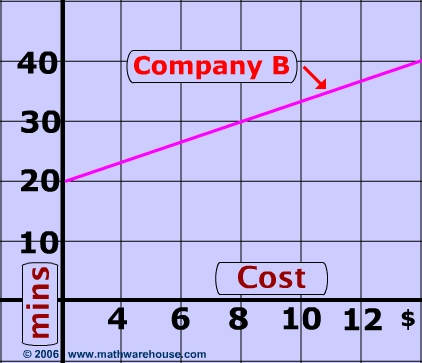How do we solve problems that involve changing costs, or other things that are in flux in our world? In Math equations are used to figure out all the possible scenarios that may occur. The equation y=mx+b shows a linear pattern that can be drawn on a graph or put into a table.
This week in Middle School we wanted to purchase several items that cost the same amount. The cost of each item was then multiplied by the # of items that we wanted to buy. This cost is called the slope, or the rate of each item. If we had a delivery fee, or other fixed cost that was included we had to add this to the equation too. When making a decision it is helpful to use the slope-intercept equation to explore the cost.
Here's a problem to get started thinking about how slope fits into real life problem solving...
Musicmatch, an online music store, charges a $10 dollar membership fee plus $.50 cents per song. i Tunes sells songs for $.99 cents each, but doesn't
charge a membership fee.
Which company offers a better deal for the music lover?
Set up an equation in slope intercept form
that can be used to find the cost for any number of songs.
The following website offers consumer reviews of different online music companies that may be an even better deal. Check them out at Music Download Reviews.
First we begin by comparing each music plan. In looking at the problem, What things could change as a person begins using each plan? We should be able to find two variables that can be represented by x and y in the problem.
After we have found the variables we look at the cost of each song. This unit cost, or slope is represented by the letter m in the slope-intercept equation. (y= mx+b) Slope is also called the unit cost, or rate of change. When setting up the equation we use slope to show the rate of increase or decrease. Slope is also how fast the rate increases or decreases. An interesting observation that students made while graphing lines on a coordinate plane was the steeper the line the greater the number of the slope. Can you identify what the slope is for the different music plans?
If not, or for more about the slope click on this hyperlink--- The slope.
The Y-Intercept on a graph shows where the line crosses the y-axis. In problem solving this can be also expressed as a fixed cost or starting point for how much a person would pay up front. For example, if a club has a membership fee that must be paid in addition to buying songs. For example, if i tunes had charged a $5.00 membership fee this would be added on to the equation. y=.99x + 5 Can you tell what the y-intercept for Musicmatch would be? Does i Tunes have a Y-intercept, why or why not?
The slope and y-intercept are written in Slope Intercept Form. (y=mx+b) As we try different values and put them in for the x=#of songs, or y=total cost, we can further explore the advantages of each music plan.
Which plan did you find to be the better deal for the music lover? What other strategies can use to solve this problem?
I found it interesting to explore music plans that are available online. It would be great to hear about other plans that are advantageous, or other links that would give data to support this inquiry.

No comments:
Post a Comment